
PRESS RELEASE
Optiarc VP Series 480GB Solid State Drive
Jul, 29 2019
Optiarc is no stranger to the data storage industry. Originally established in 2006 as a joint venture between Sony and NEC, Optiarc combined the technologies and expertise of its parent companies to provide some of the best optical drives in the world. Sony soon took over NEC's share of the company, making it a wholly-owned subsidiary. By 2013 though, Sony would be forced to shut Optiarc's doors. Despite having a 15% market share, increased competition from overseas manufacturers had forced the price of optical drives down to unsustainable levels. Thankfully, Optiarc's story does not end there. In 2017, Vinpower Digital acquired rights to the brand and re-launched it with a new series of DVD writers.
Optiarc is no stranger to the data storage industry. Originally established in 2006 as a joint venture between Sony and NEC, Optiarc combined the technologies and expertise of its parent companies to provide some of the best optical drives in the world. Sony soon took over NEC's share of the company, making it a wholly-owned subsidiary. By 2013 though, Sony would be forced to shut Optiarc's doors. Despite having a 15% market share, increased competition from overseas manufacturers had forced the price of optical drives down to unsustainable levels. Thankfully, Optiarc's story does not end there. In 2017, Vinpower Digital acquired rights to the brand and re-launched it with a new series of DVD writers.
Vinpower is also using the Optiarc brand to expand into the flash storage market. This spring, they launched Optiarc's VP series SSDs. Designed with a focus on data integrity, the VP utilizes market leading components like Phison's PS3111-S11 controller as well as Toshiba's 64-layer BiCS3 3D TLC NAND. The drive is also equipped with an enhanced firmware to better control the data flow and prevent errors or overloading at the cellular level. To top it all off, Optiarc has implemented intensive testing procedures that go far beyond the standardized mainstream testing process. The company uses state of the art hardware to test each element of every single VP series SSD to ensure long term reliability and stability.
The VP series is available in 240GB and 480GB capacities. For this review, Optiarc sent us the 480GB version of the drive which is capable of delivering up to 550 MB/s sequential read and 490 MB/s sequential write speeds as well as up to 63,000 random read and 85,000 random write IOPS.
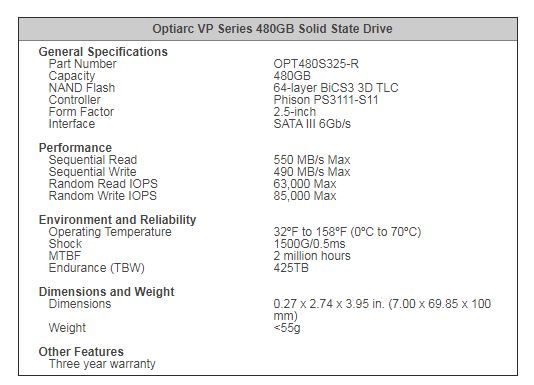

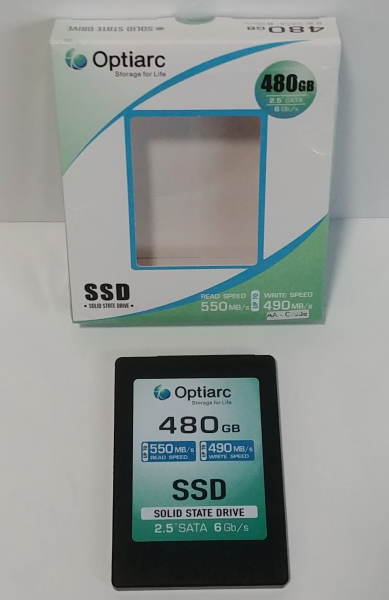
Physical Features:
The VP looks very similar to other 2.5-inch SSDs on the market today. The outer casing is made entirely out of black plastic with large, greenish-blue stickers on the top and bottom. Along with the Optiarc logo, these stickers show information like the capacity, rated speeds, part number and serial number.
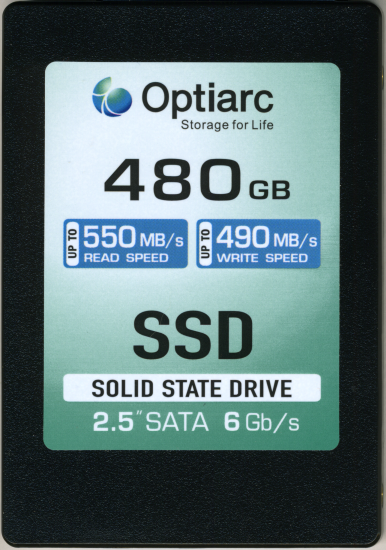
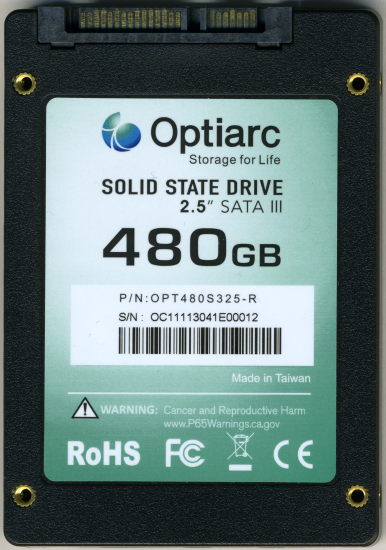
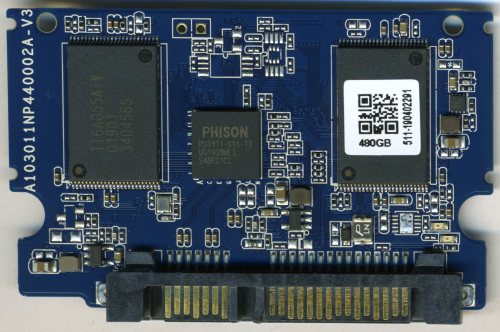
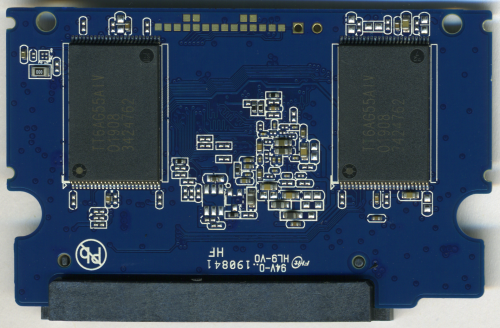
The test system used in this review is equipped with an Intel Core i7-6700K CPU, GIGABYTE GA-Z170X-UD3 motherboard, 32GB (16GB x 2) of Crucial Ballistix Sport LT DDR4 memory, Samsung 960 PRO 512GB SSD and a GIGABYTE GeForce GTX 1060 WINDFORCE OC 6G graphics card. For the operating system, I installed a fresh copy of Windows 10 Enterprise.
To test the performance of Optiarc's VP series SSD, I ran a series of benchmarks using CrystalDiskMark, HD Tach RW, ATTO Disk Benchmark, AS SSD, HD Tune Pro, Anvil's Storage Utilities, Iometer and PCMark 8. For comparison, I've also included test results from the ADATA Ultimate SU750, Samsung 860 QVO, Samsung 860 PRO, Crucial MX500, Plextor M8V, Crucial BX300, ADATA Ultimate SU900, Plextor S3C, Toshiba OCZ VX500, ADATA Ultimate SU800, Plextor S2C, Crucial MX300, Plextor M7V, PNY CS1311, OCZ Trion 150, PNY CS2211, Plextor M6V, Crucial BX200, OCZ Trion 100, Kingston HyperX Savage, Crucial MX200, OCZ Vector 180, Kingston BX100, Samsung 850 EVO M.2, Samsung 850 EVO mSATA, AMD Radeon R7, Silicon Power Slim S80, Samsung SSD 850 EVO, OCZ ARC 100, SanDisk Ultra II, Crucial MX100, SanDisk Extreme Pro and Samsung SSD 850 PRO.
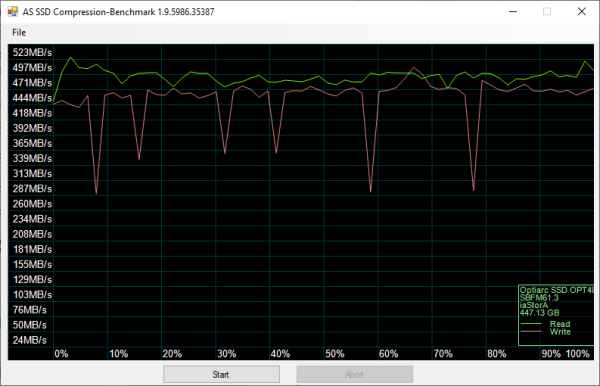
CrystalDiskMark 5.1.2:
First, I ran a few quick tests using CrystalDiskMark. This benchmark tool measures the performance of a storage device by testing its sequential read and write speeds as well as its random read and write speeds using blocks 512K and 4K in size.


Contrary to what we saw with AS SSD's compression benchmark, the VP performed better when using highly compressible 0x00 (0 Fill) data. This time around, the drive was able to read at 562.6 MB/s and write at 543.3 MB/s.
HD Tach RW 3.0.4.0:
Next, I used HD Tach to test the VP's read, write and burst speeds as well as its seek times and CPU usage.
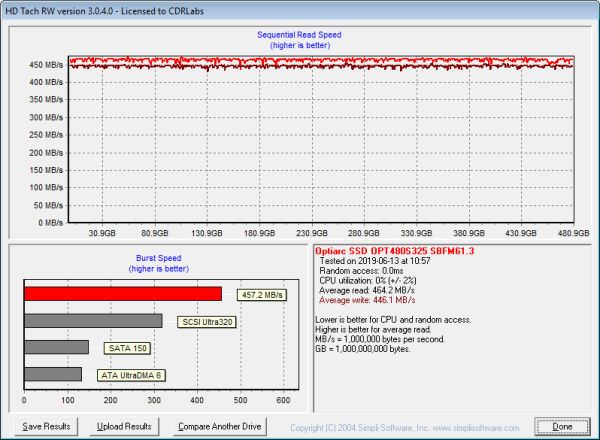
Looking at the screenshot above, you can see that the VP had average read and write speeds of 464.2 MB/s and 446.1 MB/s respectively, as well as a burst speed of 457.2 MB/s.
ATTO Disk Benchmark 2.46:
I also used ATTO Disk Benchmark to test the VP's sequential read and write speeds. The tests are run using blocks ranging in size from 0.5KB to 8192KB and the total length set to 256MB.

AS SSD:
AS SSD is a benchmark designed specifically for solid state drives. The application contains five synthetic tests which are used to determine the sequential and random read and write performance of a drive.


HD Tune Pro 5.00:
Next, I ran a series of tests using HD Tune Pro. This hard disk utility measures a drive's performance by testing its sequential read and write speeds as well as its access time, burst rate and CPU usage. For this review, I'm also going to use it to benchmark the VP's random read and write speeds, random access times and the number of operations per second.


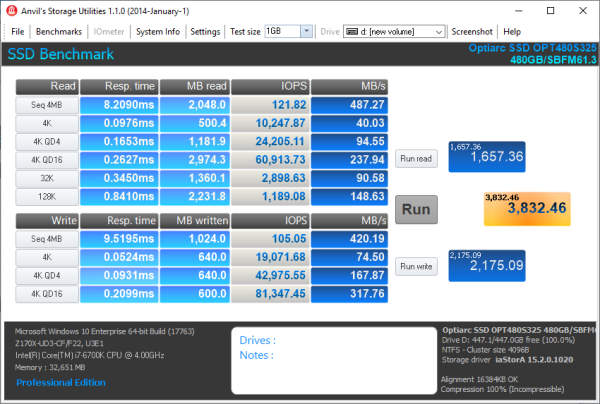
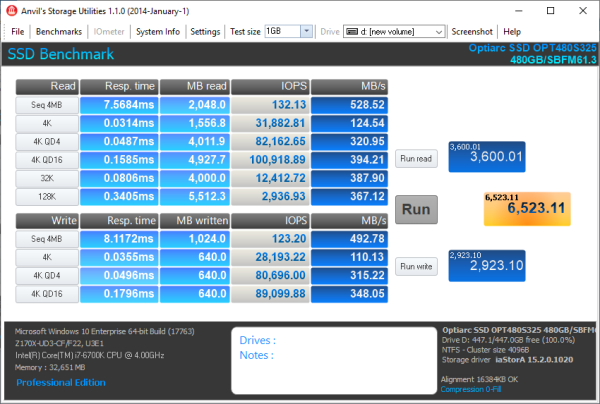
Iometer:
Lastly, I ran a series of tests using Iometer. This tool can be configured to benchmark a number of things. In this case, I used it to measure the VP's read and write speeds and the number of operations per second. The tests were run using random bytes and a queue depth of 3.
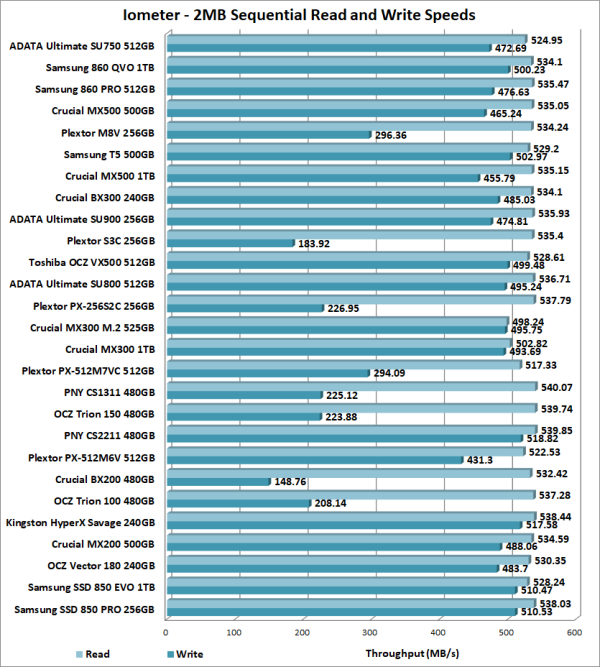
The VP's performance was very similar to what we saw in our other tests. The drive was able to read at 531.25 MB/s and write at 452.43 MB/s.
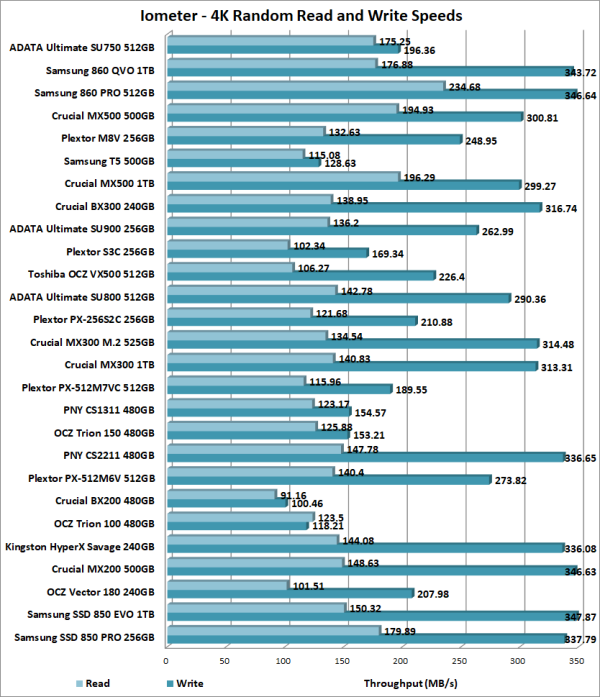
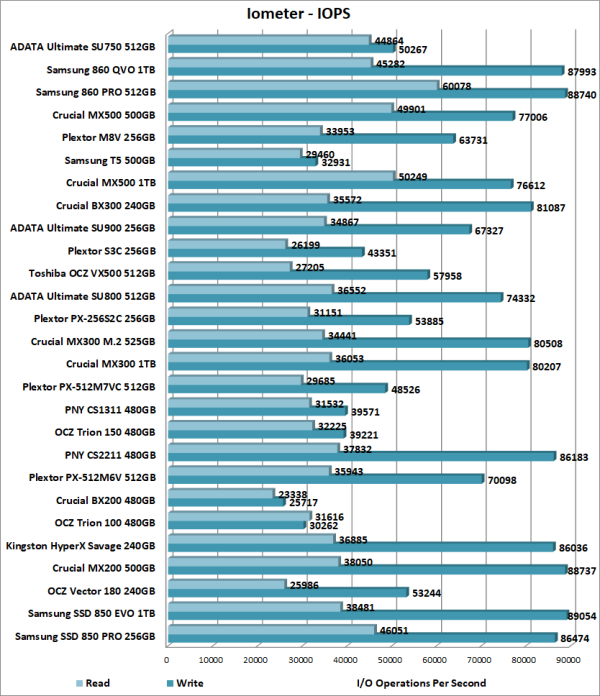
Vantage PCMark 8 - Storage Test:
PCMark 8 is a complete benchmark for Windows. It includes five benchmark tests, each designed around a specific scenario. The storage benchmark measures drive performance using real-world traces recorded from Adobe Creative Suite, Microsoft Office and a selection of popular games.
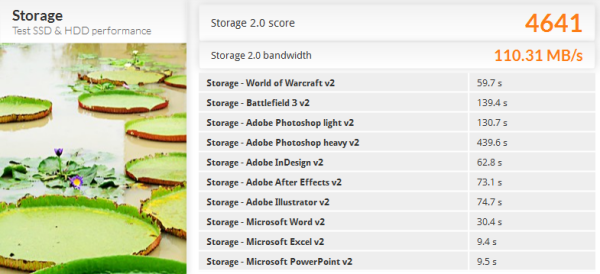
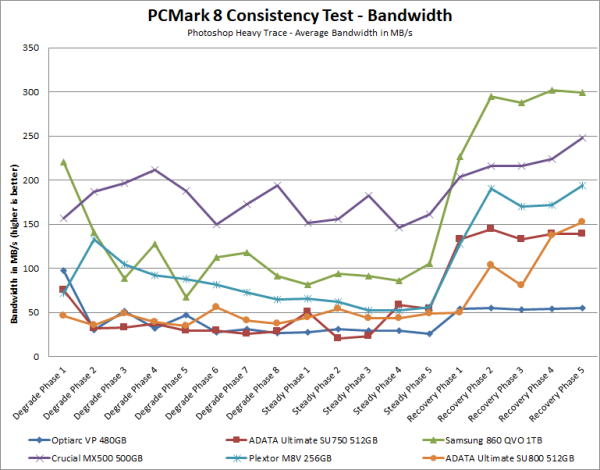
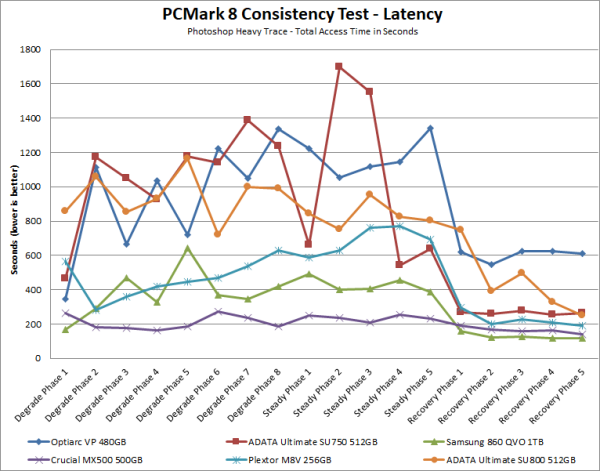
TRIM Performance:
While SSD's offer many benefits, there are some downsides to using flash memory. One of the biggest issues people run into is performance degradation. Over time, an SSD will run out of fresh blocks and will have to write over data the file system has marked as deleted. This procedure is very complicated and can slow an SSD's write speeds considerably.
To fix this problem, most manufacturers have added TRIM support to their SSDs. The TRIM command allows an operating system, such as Windows 10, to tell an SSD which data blocks are no longer in use. Using this information, the drive pro-actively erases these blocks and adds them to the free block pool.
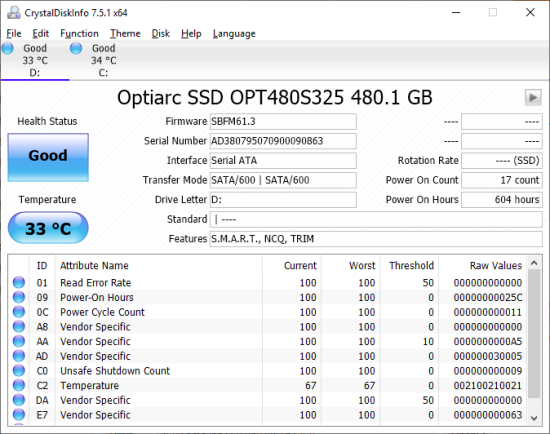
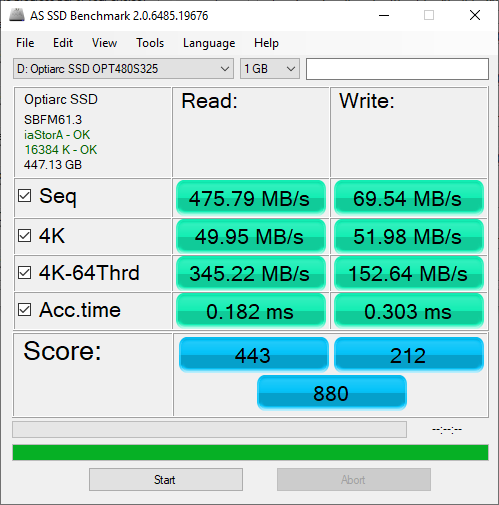
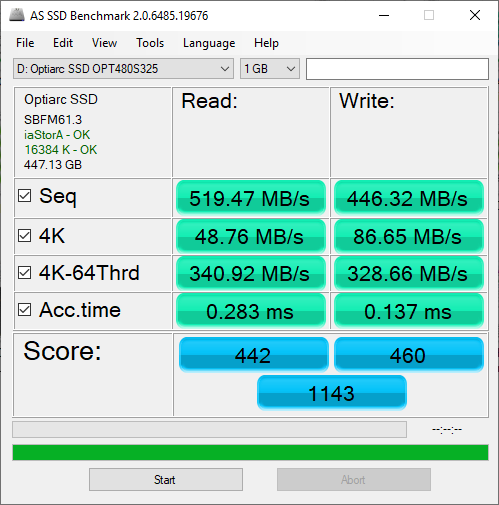
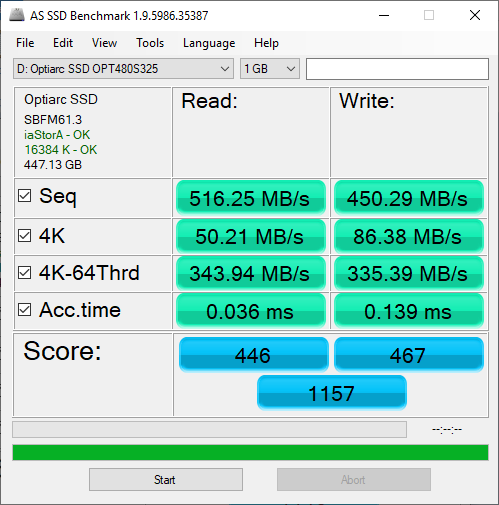
Final Thoughts:
When shopping for an SSD, people typically look at things like performance and price. What many don't realize though is that reliability is just as important, especially when you're trusting it to store your personal data. Optiarc knows this and, with their new VP series SSD, they've delivered a drive that focuses first, and foremost, on data integrity and long term reliability. Along with an enhanced firmware, the VP is equipped with high caliber components like Phison's PS3111-S11 controller and Toshiba's 64-layer BiCS3 3D TLC NAND. Furthermore, the company puts their drives through a rigorous testing process to further reduce the chance of failure and data loss.
When it came time to perform, Optiarc's VP series SSD did fairly well throughout most of our tests. In our sequential read and write tests, the 480GB version of the drive was able to read at speeds as high as 562 MB/s and write at speeds in excess of 481 MB/s. Despite the lack of a separate DRAM cache, the VP also had no problems holding its own when doing random writes, producing more than 50,000 IOPS at low queue depths.
Optiarc's VP series SSD is available now in 240GB and 480GB capacities and can be purchased directly from RunTechMedia or through Amazon.com for $35 and $55, respectively. If you need more storage, the company has plans to release 960GB and 1920GB versions of the drive by the end of the year.
Highs:
- Available in 240GB and 480GB capacities
- Phison PS3111-S11 controller
- Equipped with Toshiba 64-layer BiCS3 3D TLC NAND
- Good sequential and random read and write performance
- Tested to ensure long term reliability and stability
- Ultra-slim form factor
- Reasonably priced
- 3 year warranty
Lows:
- Not as fast when writing incompressible data
- Does not support hardware based encryption
- Not available in higher capacities (yet)